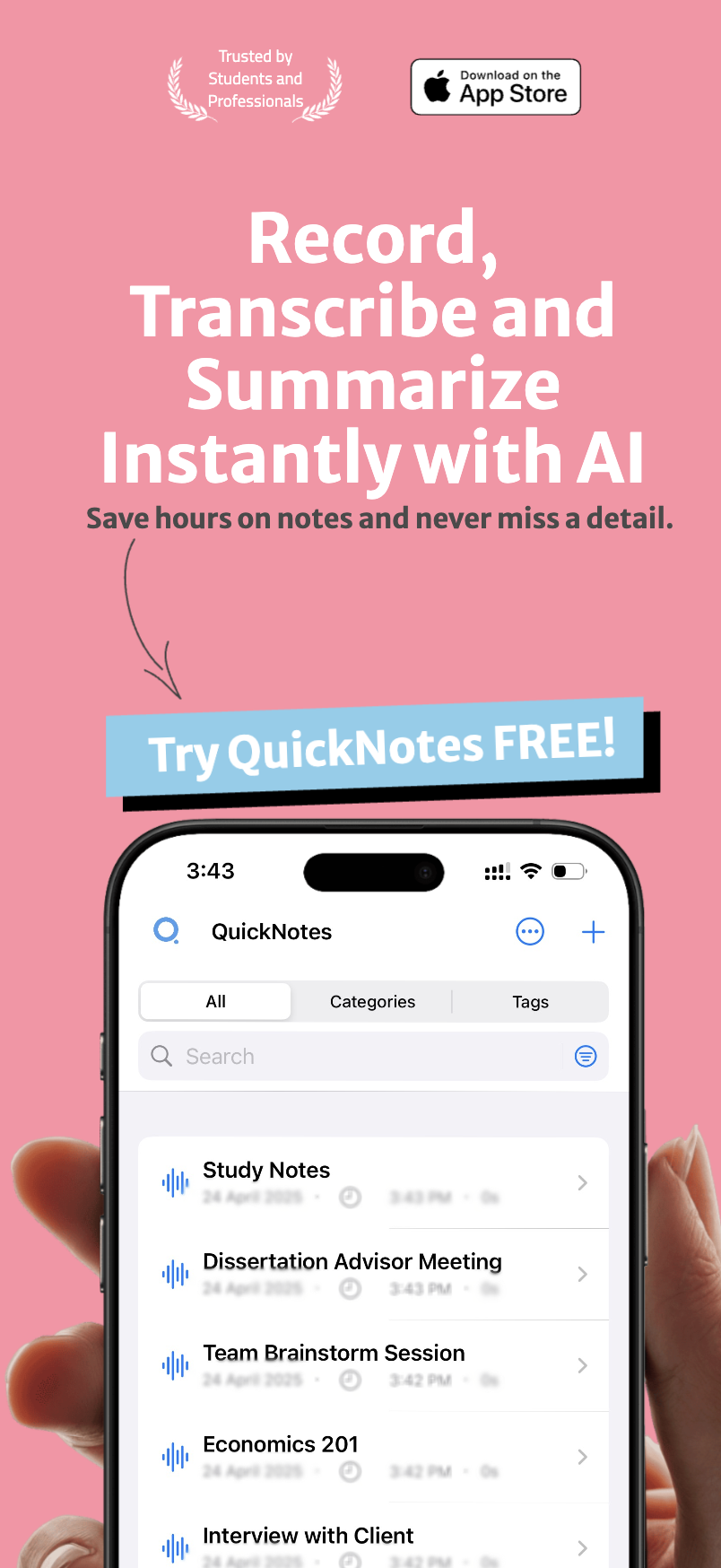When you sit down to study, what's your typical approach? If you're like most students, you probably focus on one topic or problem type until you feel you've mastered it, then move on to the next. It's a logical approach that feels productive and efficient. But what if this common "blocked practice" method is actually holding back your learning potential?
Table of Contents
- Understanding Interleaving: What It Is and Why It Works
- Blocked vs. Interleaved Practice
- The Science Behind Interleaving's Effectiveness
- The Interleaving Paradox: Why It Feels Harder But Works Better
- The Illusion of Mastery
- Productive Struggle
- Metacognitive Disconnect
- From Performance to Learning
- Implementing Interleaving Effectively
- 1. Start with Related Concepts
- 2. Create Strategic Spacing
- 3. Build Complexity Gradually
- 4. Embrace the Difficulty
- 1. Creating Topic Recordings for Easy Switching
- 2. Organizing with Categories and Tags for Interleaving Structure
- 3. AI-Powered Summaries for Concept Comparison
- 4. Speech-to-Text for Reflection and Comparison
- Sample Interleaving Session with QuickNotes
- 1. Preparation Phase
- 2. Interleaved Study Session
- 3. Reflection and Consolidation
- Combining Interleaving with Other Evidence-Based Techniques
- Interleaving + Retrieval Practice
- Interleaving + Elaboration
- Interleaving + Spaced Repetition
- Conclusion: Embracing the Challenge for Better Learning
- You Might Also Like
Enter interleaving: a powerful learning technique that involves mixing different topics or types of problems within a single study session. Though it might feel more difficult and less productive in the moment, research shows that interleaving can dramatically improve long-term retention and the ability to apply knowledge in new contexts. In this article, we'll explore the science behind interleaving, practical strategies for implementing it, and how QuickNotes can help you organize this approach for maximum benefit.
Understanding Interleaving: What It Is and Why It Works#
To appreciate the power of interleaving, it's helpful to first understand its opposite: blocked practice. Most of us instinctively use blocked practice when studying—we focus on one topic or problem type until we feel we've mastered it, then move on to the next. While this approach feels intuitive and produces a sense of rapid improvement, research shows it often leads to superficial learning that doesn't transfer well to new contexts.
Blocked vs. Interleaved Practice#
Here's a simple comparison to illustrate the difference:
- Blocked practice: AAAA BBBB CCCC (studying topic A until done, then topic B, then topic C)
- Interleaved practice: ABCBCACAB (mixing topics A, B, and C throughout the study session)
The interleaved approach creates a more challenging learning experience, but this "desirable difficulty" is precisely what makes it effective. When you interleave, you're forced to constantly retrieve different strategies and approaches, strengthening the neural connections associated with each concept.
The Science Behind Interleaving's Effectiveness#
Multiple studies have demonstrated the superiority of interleaved practice over blocked practice. In one landmark study by Rohrer and Taylor (2007), students who used interleaving to learn mathematical concepts performed 25% better on immediate tests and a remarkable 76% better on delayed tests compared to those who used blocked practice.
Why does interleaving work so well? Cognitive science points to several mechanisms:
1. Discrimination Learning
Interleaving helps you notice the subtle differences between problem types or concepts. When topics are mixed, your brain must work harder to identify which approach applies to each problem, leading to better category discrimination and more nuanced understanding.
2. Retrieval Practice
Every time you switch between topics, you're forced to recall relevant information from memory rather than simply holding it in working memory. This repeated retrieval strengthens memory pathways and improves long-term retention.
3. Contextual Interference
The cognitive challenge created by switching between topics—known as contextual interference—leads to deeper processing. Your brain works harder to keep track of different concepts, resulting in stronger neural connections and more durable learning.
"The research shows unambiguously that interleaving produces better mastery than blocked practice, despite the fact that most learners believe the opposite to be true." — Dr. Robert Bjork, Distinguished Research Professor of Psychology
The Interleaving Paradox: Why It Feels Harder But Works Better#
One of the most fascinating aspects of interleaving is what researchers call the "interleaving paradox": the approach that feels more difficult and less productive in the moment actually produces better long-term results. This creates a significant challenge for learners, as our intuition about what works best often leads us astray.
The Illusion of Mastery#
Blocked practice creates a rapid sense of improvement and confidence. When you solve several similar problems in succession, you quickly develop a rhythm and experience fewer errors. This feels good and creates an illusion of mastery—but this confidence is often misleading.
Productive Struggle#
Interleaving, by contrast, feels more challenging and even frustrating. You make more errors initially and progress seems slower. However, this "productive struggle" is precisely what leads to deeper learning and better long-term retention.
Metacognitive Disconnect#
Students consistently rate blocked practice as more effective despite evidence to the contrary. In one study, even after seeing their superior test results from interleaved practice, students still reported believing that blocked practice was better for their learning. This metacognitive disconnect highlights why deliberate adoption of interleaving requires overcoming our natural tendencies.
From Performance to Learning#
The key insight is understanding the difference between performance (how well you do during practice) and learning (how well you retain and apply knowledge later). Interleaving may temporarily decrease performance during practice but significantly enhances learning for future application.
Implementing Interleaving Effectively#
Now that we understand why interleaving works, let's explore how to implement it effectively in your study routine:
1. Start with Related Concepts#
Begin by interleaving closely related topics or problem types. For example:
- In mathematics, interleave different types of problems that use similar formulas (e.g., different types of integration problems)
- When learning languages, practice different verb tenses within the same study session
- For science courses, mix related concepts that require discrimination (e.g., different types of chemical reactions)
2. Create Strategic Spacing#
Combine interleaving with spaced repetition for maximum benefit:
- Short-term spacing: Alternate between topics within a single study session
- Medium-term spacing: Revisit topics across different days of the week
- Long-term spacing: Schedule periodic review sessions that interleave material from different units or chapters
3. Build Complexity Gradually#
As you become more comfortable with interleaving, increase the challenge:
- Start with interleaving 2-3 related topics
- Progress to interleaving more diverse or distantly related concepts
- Eventually, try interleaving across different subjects (e.g., alternating between chemistry problems and economics concepts)
4. Embrace the Difficulty#
Remember that the productive struggle is part of the process:
- Expect to feel less confident during interleaved practice
- Focus on the long-term benefits rather than immediate performance
- Use periodic self-testing to verify that you're making progress despite the challenge
The challenges of implementing interleaving effectively include keeping track of multiple topics, organizing diverse materials, and maintaining the right balance of variety. QuickNotes offers several features that can help overcome these challenges:
1. Creating Topic Recordings for Easy Switching#
QuickNotes' core audio recording functionality provides an excellent foundation for interleaving practice. According to the QuickNotes Functions documentation, the app offers "high-quality audio recording with a clean, intuitive interface."
You can use this feature to:
- Record key concepts for each topic you're studying
- Create problem-solving walkthroughs for different types of problems
- Record verbal explanations that connect related concepts across topics
Having these recordings readily available makes it easier to switch between topics during an interleaved study session without losing momentum.
2. Organizing with Categories and Tags for Interleaving Structure#
QuickNotes' robust organizational system is particularly valuable for interleaving. The app provides "Library Management" capabilities that allow you to "organize recordings by customizable categories" and "apply multiple tags to recordings for flexible organization."
This organizational structure allows you to:
- Create categories for major subjects or units
- Use tags to identify related concepts across different categories
- Create special tags like "needs review" or "difficulty level" to help structure your interleaving sessions
- Group similar problem types together while still maintaining separation for interleaving purposes
3. AI-Powered Summaries for Concept Comparison#
One of the most powerful features of QuickNotes for interleaving is its "AI-Powered Summaries" capability. The app can "generate concise summaries from transcribed content" with "adjustable length" options.
This is invaluable for interleaving because:
- Summaries help you quickly recall key points when switching between topics
- You can generate summaries that specifically highlight the differences between related concepts
- Comparing AI-generated summaries of different topics can reveal connections you might have missed
4. Speech-to-Text for Reflection and Comparison#
QuickNotes offers "Speech-to-Text" conversion with "high accuracy using advanced recognition." This feature supports interleaving by allowing you to:
- Record your reflections on similarities and differences between topics
- Create transcribed notes that compare and contrast related concepts
- Generate searchable text that makes it easier to find connections between interleaved topics
Sample Interleaving Session with QuickNotes#
Here's a practical example of how to use QuickNotes to structure an effective interleaved study session:
1. Preparation Phase#
- Identify 3-4 related topics or problem types you want to interleave
- For each topic, create a QuickNotes recording with key concepts, formulas, or principles
- Use the tagging system to mark the difficulty level and relationship between topics
- Set up a category structure that allows you to easily find related materials
2. Interleaved Study Session#
- Start with a brief review of each topic (2-3 minutes per topic) using your QuickNotes recordings
- Switch to practice problems, alternating between different problem types
- After each problem, record a brief explanation of your approach and solution
- Use the AI summary feature to highlight connections between different approaches
3. Reflection and Consolidation#
- At the end of your session, record your observations about similarities and differences between topics
- Use the speech-to-text feature to create a searchable record of your insights
- Create comparison recordings that explicitly connect concepts across topics
- Tag areas where you struggled for focused review in your next session
Combining Interleaving with Other Evidence-Based Techniques#
Interleaving becomes even more powerful when combined with other proven learning strategies. Here's how QuickNotes can help implement these combinations:
Interleaving + Retrieval Practice#
Use QuickNotes to record questions for each topic, then practice retrieving information from memory by answering these questions in an interleaved order. The recording feature allows you to check your answers against the correct information.
Interleaving + Elaboration#
After studying each interleaved topic, use QuickNotes to record elaborative explanations where you connect the new information to what you already know. The AI summary feature can help identify the most important connections.
Interleaving + Spaced Repetition#
Use QuickNotes' organizational features to schedule interleaved review sessions at increasing intervals. The tagging system can help you track when you last reviewed each topic and when it's due for another review.
Conclusion: Embracing the Challenge for Better Learning#
Interleaving represents a significant paradigm shift in how we approach learning. By embracing the productive struggle of mixed practice, you can move beyond superficial understanding to develop deeper, more flexible knowledge that transfers readily to new situations and lasts longer in memory.
While interleaving may initially feel more difficult and less productive than traditional blocked practice, the research is clear: the approach that feels harder often leads to better long-term results. QuickNotes provides the organizational structure and content management capabilities needed to implement interleaving effectively, helping you overcome the natural tendency to revert to blocked practice.
As you incorporate interleaving into your study routine, remember that learning is not about comfort—it's about growth. By challenging yourself with varied practice and using QuickNotes to manage the complexity, you're not just studying differently; you're building a more robust and adaptable understanding that will serve you well beyond the next exam.
You Might Also Like#

AI-Powered Summarization: Extract Key Insights Instantly
Learn how QuickNotes' AI summarization technology helps you extract key insights from lengthy recordings and transcriptions, saving time and improving information retention.

Organization and Tagging: A System for Effective Information Management
Learn how QuickNotes' powerful organization and tagging system helps you categorize, find, and utilize your notes and recordings effectively.

Multi-Language Transcription: Breaking Down Communication Barriers
Discover how QuickNotes' multi-language transcription capabilities can break down communication barriers and streamline global collaboration.

